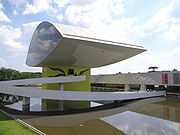
Oscar Niemeyer Museum
Encyclopedia

Oscar Niemeyer
Oscar Ribeiro de Almeida Niemeyer Soares Filho is a Brazilian architect specializing in international modern architecture...
Museum is located in the city of Curitiba
Curitiba
Curitiba is the capital of the Brazilian state of Paraná. It is the largest city with the biggest economy of both Paraná and southern Brazil. The population of Curitiba numbers approximately 1.75 million people and the latest GDP figures for the city surpass US$61 billion according to...
, in the state of Paraná
Paraná (state)
Paraná is one of the states of Brazil, located in the South of the country, bordered on the north by São Paulo state, on the east by the Atlantic Ocean, on the south by Santa Catarina state and the Misiones Province of Argentina, and on the west by Mato Grosso do Sul and the republic of Paraguay,...
, in Brazil
Brazil
Brazil , officially the Federative Republic of Brazil , is the largest country in South America. It is the world's fifth largest country, both by geographical area and by population with over 192 million people...
. It was inaugurated in 2002 with the name Novo Museu or New Museum. With the conclusion of remodeling and the construction of a new annex, it was reinaugurated on July 8, 2003, with the current denomination to honor its famous architect who completed this project at 95 years of age. It is also known as Museu do Olho or Museum of the Eye, due to the design of the building.
The museum focuses on the visual art
Art
Art is the product or process of deliberately arranging items in a way that influences and affects one or more of the senses, emotions, and intellect....
s, architecture
Architecture
Architecture is both the process and product of planning, designing and construction. Architectural works, in the material form of buildings, are often perceived as cultural and political symbols and as works of art...
and design
Design
Design as a noun informally refers to a plan or convention for the construction of an object or a system while “to design” refers to making this plan...
. For its magnificence, beauty and for the importance of the collection, it represents a cultural institution of international significance. The complex of two buildings, installed in an area of 35 thousand square meters (of which 19 thousand are dedicated to exhibition space), it is a true example of architecture allied with art. The first building was designed by Oscar Niemeyer
Oscar Niemeyer
Oscar Ribeiro de Almeida Niemeyer Soares Filho is a Brazilian architect specializing in international modern architecture...
in 1967, faithful to the style of the time, and conceived as an educational institute. It was remodeled and adapted to function as a museum, for which Niemeyer designed the annex, reminiscent of an eye
Human eye
The human eye is an organ which reacts to light for several purposes. As a conscious sense organ, the eye allows vision. Rod and cone cells in the retina allow conscious light perception and vision including color differentiation and the perception of depth...
, imprinting it with a new characteristic identity.
The museum features many of Niemeyer's signature elements: bold geometric forms, sculptural curved volumes placed prominently to contrast with rectangular volumes, sinuous ramps for pedestrians, large areas of white painted concrete, and areas with vivid murals or paintings. A collaborator previously on Ibirapuera Park with landscape architect Roberto Burle Marx
Roberto Burle Marx
Roberto Burle Marx was a Brazilian landscape architect whose designs of parks and gardens made him world famous. He is accredited with having introduced modernist landscape architecture to Brazil...
, Niemeyer's namesake museum is also within a garden designed by Burle Marx, and that within 144 thousand square meters of woodland. Though rooted in modern architecture
Modern architecture
Modern architecture is generally characterized by simplification of form and creation of ornament from the structure and theme of the building. It is a term applied to an overarching movement, with its exact definition and scope varying widely...
since his involvement in the international style
International style (architecture)
The International style is a major architectural style that emerged in the 1920s and 1930s, the formative decades of Modern architecture. The term originated from the name of a book by Henry-Russell Hitchcock and Philip Johnson, The International Style...
, Niemeyer's designs have much in common with postmodern architecture
Postmodern architecture
Postmodern architecture began as an international style the first examples of which are generally cited as being from the 1950s, but did not become a movement until the late 1970s and continues to influence present-day architecture...
as well and this is as contemporary a building as the artwork it displays.

